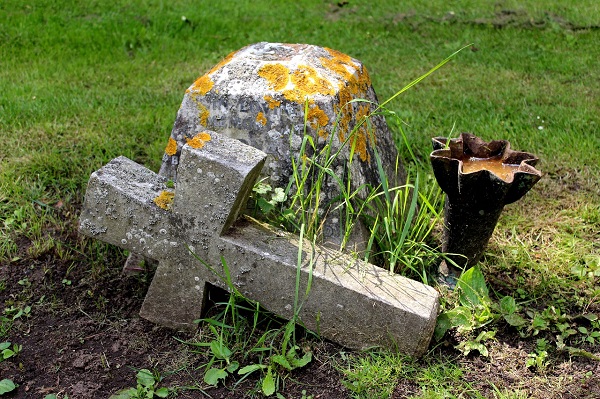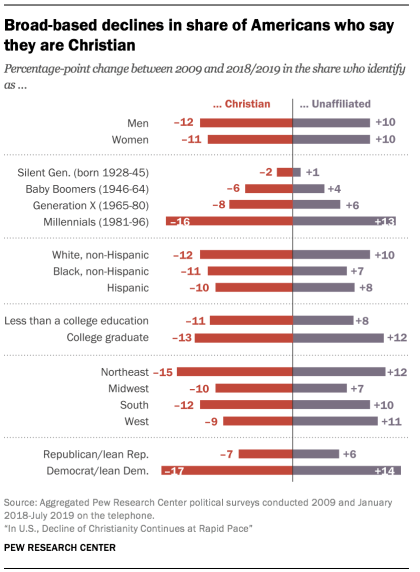
Atheists, rejoice!
In Pew Research Center telephone surveys conducted in 2018 and 2019, 65% of American adults describe themselves as Christians when asked about their religion, down 12 percentage points over the past decade. Meanwhile, the religiously unaffiliated share of the population, consisting of people who describe their religious identity as atheist, agnostic or “nothing in particular,” now stands at 26%, up from 17% in 2009.
Self-described atheists now account for 4% of U.S. adults, up modestly but significantly from 2% in 2009; agnostics make up 5% of U.S. adults, up from 3% a decade ago; and 17% of Americans now describe their religion as “nothing in particular,” up from 12% in 2009.
Every time a new poll of America’s religious landscape comes out, I get giddy. It feels like being a kid on Christmas morning. And the latest Pew survey doesn’t disappoint. The headline says it all: “In U.S., Decline of Christianity Continues at Rapid Pace“.
This survey examines changes in American religiosity over the last ten years. The headline finding is that the number of nonreligious Americans has grown by 30 million people, while Christians have suffered double-digit declines as a share of the population and a multimillion loss in absolute numbers. Within the larger nonreligious demographic, the number of people who call themselves atheist or agnostic has grown as well. (I’m at a loss why Pew says that self-described atheists have gained “modestly”, when their own data shows that our numbers have doubled.)
These findings mesh neatly with other surveys from the last few years, including one in April which showed that the nonreligious are in a statistical tie for first place, and one from last year which found that white evangelicals are dying off and could cease to be a political force as soon as 2024. The new results are further confirmation of this secular sea change.
Let’s bask in some more good news. According to Pew, the decline and fall of Christianity is across the board, not limited to a particular sect, demographic segment or geographic region:
Both Protestantism and Catholicism are experiencing losses of population share. Currently, 43% of U.S. adults identify with Protestantism, down from 51% in 2009. And one-in-five adults (20%) are Catholic, down from 23% in 2009.
…The changes underway in the American religious landscape are broad-based. The Christian share of the population is down and religious “nones” have grown across multiple demographic groups: white people, black people and Hispanics; men and women; in all regions of the country; and among college graduates and those with lower levels of educational attainment.
…Christians have declined and “nones” have grown as a share of the adult population in all four major U.S. regions. Catholic losses have been most pronounced in the Northeast, where 36% identified as Catholic in 2009, compared with 27% today. Among Protestants, declines were larger in the South, where Protestants now account for 53% of the adult population, down from 64% in 2009.
What does this look like on the ground? Here’s one example: in the archdiocese of Philadelphia, Mass attendance has dropped by half in the last twenty-five years.
Obviously, the young are leading the way, with the greatest gains in irreligiosity among the Millennials. But an intriguing finding is that Christianity has declined and “no religion” has increased by smaller margins in every age cohort, including Generation X, baby boomers and even the pre-World War II Silent Generation:

You could interpret this as younger generations deconverting their elders, but it’s also possible that this represents the emergence of nonbelievers who’ve been in the closet for decades: people who’ve always been skeptical of religion, but have been afraid to voice those doubts. Now that nonbelief has become a more socially accepted option, they feel empowered to stand up and be counted.
Although women have historically been more religious than men, they’re now joining the secular tide at the same rapid rate:
…women, like men, have grown noticeably less religious over the last decade. The share of “nones” among women has risen by 10 percentage points since 2009 – similar to the increase among men. And the share of women who identify as Christian has fallen by 11 points (from 80% to 69%) over that same period.
And among Hispanic Americans, Catholics are no longer a majority for the first time ever. It’s not because evangelicals are moving in to take their place, but because more of them are abandoning religion entirely:
In Pew Research Center RDD surveys conducted in 2018 and 2019, 47% of Hispanics describe themselves as Catholic, down from 57% a decade ago. Meanwhile, the share of Hispanics who say they are religiously unaffiliated is now 23%, up from 15% in 2009.
This is disastrous news for Republicans, as Jennifer Rubin writes. They’ve staked their party’s future on appealing to the xenophobia and bigotry of white evangelicals, and for a while, it worked. But that demographic is dying:
Considering how reliant they are on white Christians — evangelicals in particular — Republicans are unlikely to survive outside deep-red confines when they lose 12 points in the pool of the most reliable Republican voters. Republicans have created a zero-sum game wherein the increasingly racist and radical appeals to white Christians needed to drive high turnout alienates a substantial segment of the growing nonwhite and/or unaffiliated electorate… Soon, the math becomes impossible outside of highly gerrymandered congressional districts and rock-ribbed conservative states.
And an article in the Week points out, “If this rate of change continues, the U.S. will be majority non-Christian by about 2035”.
You might be wondering, as I was, how Christians are dealing with this news. My co-author Jim Haught had a post this week reporting on the sinister mutters of a vast left-wing conspiracy.
But I came across a response that takes a different tack: a very surprising article in the Christian Post which cheerily announces that atheism is dwindling and encourages evangelicals to be magnanimous about it:
God is big enough for you to befriend an atheist.
And you better do it quickly, too. Apparently, atheism is in decline. And how much a bummer would that be, to not have befriended an atheist when you had the chance?
It turns out that this claim comes from Gordon-Conwell Theological Seminary, an evangelical Christian school, which released a “Status of Global Christianity 2019” report. Said report claims that the number of atheists peaked in 1970 (?!) and has been shrinking ever since. It also predicts that the number of agnostics and of nonreligious people has peaked this year and both will decline from now on.
As you might imagine, I was intensely curious how they arrived at this result, since it flies in the face of polls showing steady growth of the nonreligious throughout the Western world. The GCTS report provides no footnotes for these figures, but I e-mailed them to ask and got this response:
Purely demographic changes do not show a precipitous decline in religious adherence. Religionists generally have higher birthrates than the non-religious and death rates for both are similar… At present, the best quantitative tools for projecting the religious future of mankind forecast the perseverance and even flourishing of religion. By these estimates, religionists would make up 91.3% of the world’s population in 2050, up from 80.8% in 1970 (when the percentage of non-religious peaked worldwide in the twentieth century). Early gains after 1970 in the percentage of religionists were as a result of the collapse of Communism in the Soviet Union, while future gains are likely to come from the resurgence of religion in China.
Their argument is that fertility is falling in developed countries with lower rates of religious adherence, while it’s rising in developing regions of the world, especially sub-Saharan Africa, which is dominated by Christians and Muslims. (I still have no explanation for their claim that global atheism peaked in 1970… unless they’re just assuming that everyone who lives under a communist government is automatically an atheist, which would nonsensically imply that atheism rates plunged overnight when the Soviet Union dissolved.)
This is certainly a possible scenario, but it offers no support for the idea that atheism is “in decline”. If anything, generational turnover in the West is going to replace older, more religious cohorts with younger, less devout ones, which means these countries’ nonreligious populations can continue to grow even as their total populations decrease. It also assumes that the developing world, as it becomes more educated and prosperous, won’t follow the same secularization curve that Western societies have experienced.
If the decline of Christianity follows the classic five stages of grief, then the religious right is still deep in the denial stage. As in that Christian Post article – or this one with an even more delusional headline, “The U.S. Church Isn’t Dying and Young People Aren’t Fleeing” – they’ve convinced themselves that this is all a bad dream, that none of it is true and their future is bright. So much the better for us, if they intend to sit back and let it happen.
Image: Mariusz Matuszewski, via Pixabay